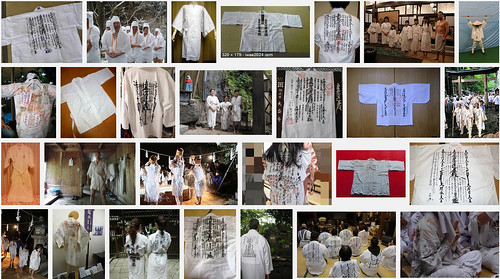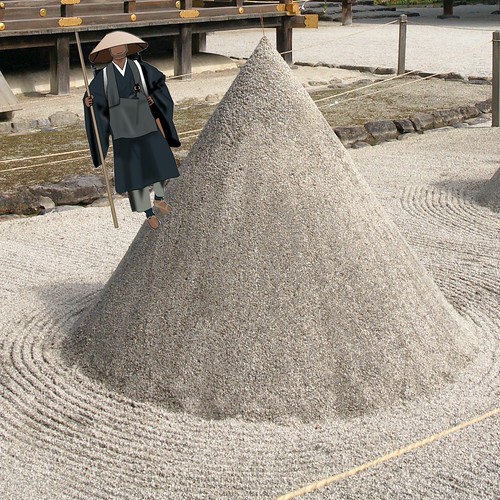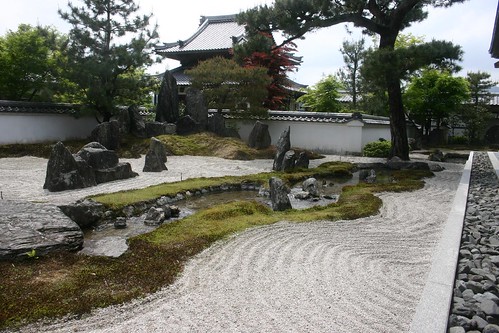Friday, March 11, 2016
Stamped on their Person

Why is it that we feel that each and every instance of a word has the same meaning, and can be copied perfectly authentically such as to make copies equivalent, and redundant? Answers to this question vary, but according to Derrida they all imply a "presence," either of some entity such as a metaphysical world of ideas (Plato, e.g. Theaetetus), meanings that are hard-wired in the brain (Pinker, 2007) , or because they refer to a shared physical world (Pierce, 1973). Others posit an ongoing inter-subjective presence, of God, the super-ego, super-addressee who understands words in the same way. At the middle ground between these two extremes is perhaps an awareness of usage: an abstraction from inter-subjective communication (Wittgenstein, 1973).
The Japanese may believe, as argued by Mori (1999), that words exist in the absence of any shared additional presence across iterations. Japanese words may lack both shared system and the perspective of a "third person" intra-psychic imaginary friend . Words are contextual and imbued with the subjectivity of the situation in which they were received. In this case copies of words are no longer redundant any more than are views of colours, flowers or sunsets. Words thus conceived are not authentically copyable, but need to be received.
When on pilgrimage, Japanese have traditionally collected words from spatially separate sites. These words do not sink into a system, nor are consumed by any internal friend. They are collected by having them stamped into cards, or books that pilgrims hang around their necks, or as in the above image, onto the clothes that they wear upon their person.
I am again reminded of Revelation 22:4. "There will no longer be any curse..."
The above image is the Google image search page for pilgrim's clothes (gyoue)
Derrida, J. (2011). Voice and Phenomenon: Introduction to the Problem of the Sign in Husserl’s Phenomenology. Northwestern Univ Pr.
Mori, 森, 有正. (1999). 森有正エッセー集成〈5〉. 筑摩書房.
Peirce, C. S. (1894). What is a sign? Theorizing Communication: Readings across Traditions, 177. Retrieved from www.semioticadelprogetto.it/download/CSP%20-%20What%20is%...
Pinker, S. (2007). The language instinct: How the mind creates language. Harper Perennial Modern Classics.
Plato, 427? BCE-347? BCE. (1999). Theaetetus. (B. Jowett, Trans.). Retrieved from www.gutenberg.org/ebooks/1726
Wittgenstein, L. (1973). Philosophical Investigations (3rd ed.). Prentice Hall.
Labels: authenticopy, derrida, nihonbunka, 日本文化
Climbing Authenticopies

Edo period Japanese were fond of visiting Ise Shrine, other shrines and temples, and also famous mountains, none more so than Mount Fuji. However the purpose of visiting Mount Fuji was not to enjoy the view from the top, which as the saying goes is preferred only by stupid bigheads and smoke (baka ya kemuri ha takai tokoro ga suki). So instead of climbing the mountain, they more often chose to climb a model of the mountain, wearing full pilgrim's attire, at one of the shrines at the base of Mount Fuji (Ohwada, 2009, p. 40: quote in Japanese below).
There is no size information in the visual. A bonsai tree looks the same as a massive oak, and a model of Mount Fuji can look the same as the real thing. If you wear the right kit and walk up a model, then you might as well have walked up the actual mountain, because they will look the same way. In he land of the sun-goddess the authenti-copies or simulacra (Baudrillard, 1995) are not words, which Westerners feel to be perfectly copyable because we have a listening comforter, but visual replications such as of mountains in front of Shinto shrines.
Japanese culture is rife with authenticopies such as bonsai, model food in place of menus, dolls, horse and cow sculptures at shrines, masks, pictures of the deceased and his royal highness the emperor, and the god-head (goshintai) of the deities themselves that can be copied or split 'as one can split a fire' (Norinaga, see Herbert, 2010, p.99). The practice of visiting copies continues to this day in the form of creating foreign villages ("gaikoku mura") which fascinate foreign anthropologists and tourism theorists (Graburn, Ertl, & Tierney, 2010; J. Hendry, 2000; Joy Hendry, 2012; Nenzi, 2008). I don't think that they have noticed that the Japanese world is inside out yet, however.
If it were indeed the case, as argued here, that the Japanese world is that of light, an amalgam of images, seen and 'insured' by the watchful eye of the Sun goddess, then in order for someone to pass from Western to Japanese culture, from a Western to Japanese world, they would need to pass through the veil of perception. Perhaps all one really needs to do is find the dead girl that you are talking off to.
Perhaps that is what David Lynch (1992) meant by "Walk fire with me".
The above image is composed of a detail from the model mountains (though not of Mount Fuji) or standing sand (tatesuna) in Kamowake-Kazushi Shrine precinct by 663highland, and image of a monk in a straw hat from gatag copyright free image source.
富士山の場合は、富士山に実際に登山していわゆる富士山禅定(ぜんじょう・登る=修行)を行う者はむしろ砂苦、大多数はしないの富士山神社や諸社寺境内に設けられた箱庭式で模擬登山を行うのであった(大和田, 2009, p. 40)
Bibliography
Baudrillard, J. (1995). Simulcra and Simulation. (S. F. Glaser, Trans.). Univ of Michigan Pr.
Graburn, N., Ertl, J., & Tierney, R. K. (2010). Multiculturalism in the New Japan: Crossing the Boundaries Within. Berghahn Books.
Hendry, J. (2000). Foreign Country Theme Parks: A New Theme or an Old Japanese Pattern? Social Science Japan Journal, 3(2), 207–220. http://doi.org/10.1093/ssjj/3.2.207
Hendry, J. (2012). Understanding Japanese Society (4th ed.). Routledge.
Herbert, J. (2010). Shinto: At the Fountainhead of Japan. Taylor & Francis.
Lynch, D. (1992). Twin Peaks: Fire Walk with Me.
Nenzi, L. N. D. (2008). Excursions in identity: travel and the intersection of place, gender, and status in Edo Japan. University of Hawaii Press.
大和田守. (2009). こんなに面白い江戸の旅. (歴史の謎を探る会, Ed.). 東京: 河出書房新社.
Labels: authenticopy, japanese culture, Nacalian, nihobunka, Shinto, tourism, 日本文化
Monday, June 29, 2015
The X-Ray Eye in the Sky

Ball and Torrance (1978: see Kim, 2002) demonstrated that the Japanese can visualise inside things. Since as demonstrated by our research they have a sort of mirror in their heart (Heine, Takemoto, Moskalenko, Lasaleta, & Henrich, 2008) their internal visualisation ability applies to their underwear, car interiors and hearts. This self directed eye is not something that the Japanese are fully aware of, but is rather the eye of the Other of the Japanese self, their super-ego which also prevents them from writing graffiti in toilet stall, or robbing people even in the dark. The eye in the Japanese sky sees inside things, and in infra-red too, but perhaps not quite so well. Tthe Japanese do tend to get a little more boisterous at night, and there is a division of what one is and is not allowed to do before and after sundown - specifically drink alcohol.
Image bottom left from Vip Style Magazine (July, 2015) p. 131
Image bottom right copyright 株式会社雅
お取り下げご希望でありましたら、下記のコメント欄かnihonbunka.comまでご連絡ください。
Ball, O. E., & Torrance, E. P. (1978). Culture and Tendencies to Draw Objects in Internal Visual Perspective. Perceptual and Motor Skills, 47(3f), 1071–1075. doi.org/10.2466/pms.1978.47.3f.1071
Heine, S. J., Takemoto, T., Moskalenko, S., Lasaleta, J., & Henrich, J. (2008). Mirrors in the head: Cultural variation in objective self-awareness. Personality and Social Psychology Bulletin, 34(7), 879–887. Retrieved from www2.psych.ubc.ca/~heine/docs/2008Mirrors.pdf
Ball, O. E., & Torrance, E. P. (1978). Culture and Tendencies to Draw Objects in Internal Visual Perspective. Perceptual and Motor Skills, 47(3f), 1071–1075. doi.org/10.2466/pms.1978.47.3f.1071
Heine, S. J., Takemoto, T., Moskalenko, S., Lasaleta, J., & Henrich, J. (2008). Mirrors in the head: Cultural variation in objective self-awareness. Personality and Social Psychology Bulletin, 34(7), 879–887. Retrieved from www2.psych.ubc.ca/~heine/docs/2008Mirrors.pdf
Labels: authenticopy, japanese, japanese culture, nihonbunka, 日本文化
Wednesday, October 03, 2012
Profesional Co-Sleepists
There are a lot of reasons why this services is available in Japan as opposed to anywhere else.
The central theory espoused by this blog (burogu.com) is that the Japanese live in the visio-imaginary. That is to say that the visual and imagined is the most important media/channel and felt to be the most real part of the world. This is because instead of having simulated/internalised a thou, super-addressee, Other, or generalised other of self-speech, the Japanese have internalised a generalised point of view. The Japanese can see themselves from the eye of the Other.
This means that things that look the same, are, for most practical purposes, the same. Thus shrines and temples, foreign villages (gaiku-mura), food (plastic food), art works, offerings (horse sculptures and drawings called ema), and people (robots, and co-sleepists) can be copied and will be felt to be the same as, or almost the same as the original.
This encourages the Japanese to purchase far more copyist services, such as women that sit next to your and laugh at your jokes (the main job of a snack hostess), people who clean our your ears (the typical behaviour of a mother or doting female) or someone to sleep next to you, the behaviour again of a girlfriend. The Japanese do not limit themselves to prostitution (which in its coital form is illegal) but purchase all sorts of soft services that people from Britain would only require from someone who had the correct "internal" states.
The tag line of the website says, "it is just enough to have you sleep next to me". Their major clientèle are tired men in their 30s to 40s.
This brings me to another reason that Japanese are more inclined to purchase co-sleeping services. The Japanese sleep with their children. Children sleep between their parents. They are brought up feeling very secure and loved. This means that the parents on the other hand far more rarely get to sleep with someone of their own size at least. Hence the need for this service.
Labels: authenticopy, image, japan, japanese culture, nihonbunka, sex, 日本文化
Friday, July 06, 2012
Cosplay Mimics the Visual Visually, Impersonation Mimics the Voice Vocally
Cosplay refers to wearing a COStume to play or mimic a cartoon (anime) or comic (manga) character. It is particularly popular in Japan where there are large events held periodically where costumed people like the lady above, get together. Cosplayers can also be seen in the Harajuku area of Tokyo, and all over Asia, and now the world, since Cosplay has spread out from Japan. In Japan it is far from being a widespread phenomena. It is the sort of thing that like dancing, the Japanese would not want to do badly. Cosplayers will go to considerable lengths to get their clothes, hair, make up and poses just right.
Cosplay is doubly visual. Firstly, cosplayers rarely speak but rather just pose, often for photographs. Their mimicry is a visual art. Secondly the object of their mimicry - the cartoon and comic characters - are particularly visual existences. I will argue that Japanese comics are more visual, hyper-visual when compared with Western cartoons and graphic novels in another post but here I want to suggest that cosplay is the predominantly visual mimicry of the predominantly visual.
These Japanese cosplayers are strange eh? I can feel "conformist," tripping off readers' lips, because isn't copying always conformism? Yes, copying is always to an excent conformism but please see the last paragraph. And futher, the Japanese are not, Asians are not, particularly conformist. Does this lady look conformist to you? Doesn't she look weird? She may still look conformist because she is not speaking. Without speech it may seem as if she has less personality than an endless loop tape recorder (see previous post) but, that is because Westerners are logocentrist.
Performing a Nacalian transformation, the Japanese Cosplayer in the imaginary is equivalent to the Western voice player, more commonly refered to as the impersonator*.
Back when I lived in the UK I used to mimic vocally a purerly vocal existence: "Mr. Angry" of the "Steve Wright in the afternoon" radio show. I was the UK equivalent of a Japanese Cosplayer. I was as conformist, but probably not as good. I would not have done it had I thought my mimicry would not be recognised however. My voice (like the appearance of the Japanese) is not something that one plays with lightly.
It seems to me that Western impersonators are Nacalianly transformed Cosplayers because they predominantly vocally mimic predominantly vocal existences. This is not to argue that Japanese cosplayers say nothing at all, or the Western impersonators do not change their appearance at all, but there is a strong difference in emphasis. The personality or self that is mimicked and does the mimicking is felt to reside in the face and appearance in Japan, and the words and voice in the West.
Please have a look at some impersonators on Youtube. You will see that not only do they change their appearance very little, but also that they choose particularly characteristic voices to impersonate. For that reason, Christopher Walken, and Al Pachino are comon favourites. Cosplayers choose characters that are easily visually recognisable such as Hatsune Mikku above. While the days of radio - such as the Goon show - are gone, and all characters these days have visual and verbal aspects, the characters that are impersonated in the West are defined, as Westerners are defined, above all by our words and voice.
Here are some Western
Finally it should be noted that to a degree Westeners are all impersonations, and the Japanese are all cosplayers, because the self is nothibng more or less than self mimicry, there is not self, no individual other than in this attempt at duplication. The self is created through an attempt to visualise oneself, or narrativally impersonate oneself into existance.
This post was inspired by a kind question from Mudakun.
Notes
*There are also impersonators in Japan, just as their are fancy dress parties in the UK but I argue that Japanese impersonation (monomane) even or especially rakugo, is extremely visio-imaginary. Please see this introduction to rakugo in English.
Labels: authenticopy, collectivism, individualism, Jaques Lacan, mime, mirror, Nacalian, nihobunka, nihonbunka, reversal, specular, 日本文化
Friday, June 22, 2012
Virtual Tourism, Reality and Wrapping
Those that can do not have the time to come to this one temple can enjoy a virtual tour via a map, especially a traditional Japanese map which provides a bird's eye view, and those that do not have the mental age to figure their way around a real map (Imao, 2005; see image right), even a Japanese birds eye view map (see image right), can play a game of "Sugoroku" (image bottom left), which is a Japanese board game, a little like snakes and ladders, played on a simplified map: virtual tourism for all the family.
When you are as good at imagining things as the Japanese, when you see a world that is visual, when you see the light, where perhaps the "Madness of the Day" (Blanchot, 1995) is rather a normal frame of mind, then you do not travel to *see* things at all. You can visit copies, watch pictures, imagine them and dream of them even with other people (Nenzi, 2008, p189) . When the Japanese travel, it is for the authenticity of the icons that they can receive there. Conversely believing them to be perfectly copied in human and minds (and the omnipresent mind of the logo-god) Westerners would never travel for signs. Does anyone reading this description of Japanese culture feel like they are travelling? While western tourists go to Gaze (Urry, 2002), the Japanese co to have signs indicated to them. Conversely if the gaze is important to the Japanese tourist at all it is autoscopically, via photography taken of themselves (kine shashin) and if signs are important to Western tourists it is primarily there ability to narrate themselves at the site, auto-semiotically, self narratival in the post-cards (Derrida, 1987) and or, which is, their self-narrative.
This difference in tourism preference, for Western gazing and Japanese icon (or 'stamp,' or fuda) collecting reflects a different world view. For Westerners the world is a dark, "The-Matrix" like world of the things-in-themselves, Konigsbergian (Nietzche, 2007), and robotic (Beaton, 2005). For Japanese the real world is the visual world, the tain of the mental mirror (Nishida 1988; Heisig, 2010).
The difference in tourism also reflects a different view of the stuff, the fluff, that, spreads out the real world, allows for the private other distinction, and moves about, the stuff that needs to be exchanged and brought back.
For Westerners it is the image that stands between ourselves and the world as word. The image is but a boundary, "hymen," or wrapping. On the one hand, the image is a wispy neurological effervescence - qualia -, on the other it is like coat of ever so thin paint. By covering the real world the image promises that the real world is out there. It is a reflection of the real world that we must travel to see. The image is the pseudo-event (Boorstin, 1992) that promises us that there is something called reality (Baudrillard, 1995).
But Baudrillard (1995) is wrong to think that this separating function -- Derrida's grapheme, pharmakon, or hymen (Derrida, 1998), wrapping (Hendry) -- is universally enacted by the image.
In Japan it is the symbol that provides the same division. It is the symbol that separates and allows a view of the world to be, at the same time private belonging to a certain person with a certain name, and at the same time the world itself. It is the symbol that Japanese travel to receive, to allow us to conceive the images that are the world, including images that at 'ruins of identity' (Hudson, 1999) have long since become invisible.
The Western "world" is like a steel framed building covered in reflective glass. The Japanese world is a tapestry pinned down and out by name-places (meisho).
Afterword
The beautiful Amadia Temple is behind Yoshimatsu Store, which is opposite Futajima Primary School, Yamaguchi City. There are so many stone Buddhas that the temple feels crowed and that one is being watched. I recommend going in the early evening when the setting sun makes the statues glow. You may see the light!
Bibliography
Baudrillard, J. (1995). Simulcra and Simulation. (S. F. Glaser, Trans.). Univ of Michigan Pr.
Beaton, M. (2005). What RoboDennett still doesn’t know. Journal of Consciousness Studies, 12(12), 3–25.
Blanchot, M. (1995). The Madness of the Day. Station Hill Pr.
Boorstin, D. J., & Will, G. F. (1992). The image: A guide to pseudo-events in America. Vintage Books New York.
Derrida, J. (1987). The Post Card: From Socrates to Freud and Beyond. (A. Bass, Trans.) (First ed.). University Of Chicago Press.
Derrida, J. (1998). Of grammatology. (G. C. Spivak, Trans.). JHU Press.
Heisig, J. W. (2010). Nishida’s Deodorized Basho and the Scent of Zeami’s Flower. Frontiers of Japanese Philosophy 7: Classical Japanese Philosophy (p. 247–73). Nagoya: Nanzan Institute for Religion and Culture. Retrieved from nirc.nanzan-u.ac.jp/staff/jheisig/pdf/Nishida%20and%20Zea...
Hendry, J. (2000). Foreign Country Theme Parks: A New Theme or an Old Japanese Pattern? Social Science Japan Journal, 3(2), 207–220. doi:10.1093/ssjj/3.2.207
Hendry, Joy. (2012). Understanding Japanese Society (4th ed.). Routledge.
Hudson, M. (1999). Ruins of identity: ethnogenesis in the Japanese Islands. University of Hawaii Press.
Imao, K. 今尾恵介. (2005). 日本地図のたのしみ. 角川学芸出版.
Nenzi, L. N. D. (2008). Excursions in identity: travel and the intersection of place, gender, and status in Edo Japan. University of Hawaii Press.
Nietzsche, F. (2007). Twilight of the Idols. Wordsworth Classics.
Nishida, K. 西田幾多郎. (1988). 西田幾多郎哲学論集〈2〉論理と生命 他4篇. 岩波書店.
Reader, I. (2005). Making pilgrimages: Meaning and practice in Shikoku. University of Hawaii Press.
Urry, J. (2002). The Tourist Gaze. SAGE.
Hansei/Critique
The idea behind this post was...I have mumbled a lot about how tourism practices suggest that Westerners and Japanese have different views of reality, but (after reading some Baudrillard) here I wanted to focus on the areality, the accursed share, the ghostly, sacrificial, supplemental, 'wrapping' of each culture. Philosophers East and West, Nishida and Dennet, can go on and on about their views of the reality of the world (as idea, or as place/space) but Frenchies like Derrida and Lacan, talk about the remainder, the other (in each case, the centre of the other) which is far more interesting, playful, sexier. The Frenchies teach us us that the other in their culture is in fact pivotal, necessary, transforming (henshin). I wish I were French!
Though they don't believe in Kant (great pun there) the Japanese love to collect signs. Though they don't believe in images, Westerners love to go and see them.The other of each culture is fun.
Self-analysis
I think that deep down I would like people like Hendry to read my blog in awe:-) Of course my blog is almost definitely rhubarb and even if it were not, the chances of Prof Hendry happening this way are next to zero but, I feel that I would like her to read the above and realise that her wrapping, her use of the word "wrapping" (what?!) betrays incalcitrant Englishness. Professional, famed anthropologist that she is, living in Japan as she did, she failed to notice (save for a jibe at Barthes) that the Japanese world is inside out. How could you fail to notice Joy? Ha! Gosh I am such a loser:-) Or I wish that someone would be impressed. Or perhaps I want to practice my English? I only speak English on this blog.
Overtly, I am hoping that, when I have written 400 blog posts, that I translate them into Japanese, and sell my blog as a Japanese language book.
Labels: authenticopy, autoscopy, japanese culture, 日本文化, 自己視
Wednesday, August 17, 2005
Early Nissan
I say almost because, Nissan was recently purchased, or part purchased by the French car manufacturer Renault, and this despite the fact that Nissan makes much better cars. Very few Renault cars are sold in Japan, where as Nissan cars are fairly popular in Europe, and have to be limited by "voluntary restrictions". Nissan is good at manufacturing but poor at financial planning. Renault had lots of cash but did not want to invest in its own manufacturing. Hence the Renault investment in Nissan. A marriage made in heaven. As a Brit I only wish that it could have been Austin Rover that had the cash left to purchase Nissan.
Labels: authenticopy, japan, japanese culture, nihonbunka, 日本文化
Zen Garden
The Zen Garden represents the cosmos I have heard it said. It seems to me that many a Zen garden look like geographies in miniature so that looking at one for a while ones mind starts to play tricks, and the gravel looks like the sea and the rocks like, or patches of grass like islands. The significance of this is, in my opion, like the Kanon bodhisattva statue that appears to be in motion even though it is stationary, to encourage the viewer to realise that scale and motion are in the mind of the beholder. Or that ultimately everything is in the mind of the beholder, and that the data, the pure experience is "mu" (chaos, nothing, Buddha nature) .
禅の庭は宇宙を表しているといわれていると思いますが、自分的に上のような庭はもっと規模の大きい風景を思い浮かばせます。禅の庭をみていると砂利が海にみえたり岩が島に見えたりするという錯覚が生じます。これは動いていないのに、動いているように見える観音菩薩像と同様、規模や動きは見ている人の心の問題であって、知覚されるデータ、その「純粋体験」に内在するものではなく、後者は「無」・「仏心」であることを示しているように思います。
Labels: authenticopy, japan, japanese culture, nihonbunka, 日本文化
Imitation Church
The company that employs these priests in the Fukuoka Area is however run by fairly serious Christians who insist that the sermon be carried out according to full Christian tradition complete with Christian vows, and readings from the bible. When real churches are used, then real priests often use the opportunity to preach to their heathen audience who otherwise very rarely come to church. For many Japanese, while they enjoy consumerism and a visit to a short stay hotel at Christmas, wedding ceremonies are the only time they enter a church.
This imitation church is an example of an authenticopy, a copy of something that is felt to be quite satisfactory in surving its purpose, and identical in that sense to that which it copies, because it looks like the real thing.
Labels: authenticopy, japan, japanese culture, nihonbunka, 日本文化
This blog represents the opinions of the author, Timothy Takemoto, and not the opinions of his employer.



![Varieties of [Virtual] Tourism, Reality and Hymen by timtak](http://farm8.staticflickr.com/7256/7418491170_a4cdc64b33.jpg)


